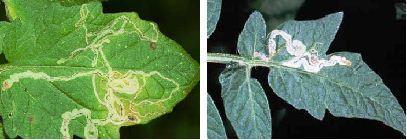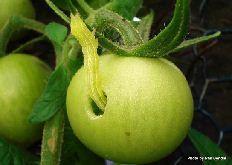Tomato: Insect and Pests Management
Tomato: Insect and Pests Management
Serpentine leaf miner
Biology- Egg: Eggs are minute in size and orange yellow in colour. The egg hatches in 4 days.
- Larva: Apodous maggot feeds on chlorophyll mining in between epidermal layers. Full grown maggot measures 3 mm. Larval duration is about 7 days.
- Pupa: Pupation is in soil. Some pupae are found in leaves. Pupation takes place inside a thin loose mesh of silken cocoon. Pupal period is about 7 days.
- Adult: It is a pale yellowish fly, measuring 1.5 mm in length. The female fly punctures upper surface of leaf to lay eggs singly. Total life cycle takes 3 weeks.

- Leaves with serpentine mines
- Drying dropping of leaves in severe cases
- Warm weather conditions are favourable for multiplication.
Gram pod borer
BiologyIt is a polyphagous pest, infesting gram, lablab, safflower, chillies, groundnut, tobacco, cotton etc.
- Egg: Spherical, yellowish eggs are laid singly on tender parts and buds of plants. The egg period lasts for 2-4 days.

- Larva: Caterpillars are of varying colour, initially brown and later turn greenish with darker broken lines along the side of the body. Body covered with radiating hairs. When full grown, they measure 3.7 to 5 cm in length. The larval period lasts for 18-25 days. The full grown caterpillar pupates in the soil.
- Pupa: Pupation takes place inside the soil in an earthen cell. Pupal stage lasts 7-15 days.
- Adult: Moth is stout, medium sized with brownish/greyish forewings with a dark cross band near outer margin and dark spots near costal margins, with a wing expanse of 3.7cm.
- Young larva feeds on the leaves for some time and then attacks fruits. Internal tissues are eaten severely and completely hollowed out. While feeding the caterpillar thrust its head inside leaving the rest of the body outside.
- Bored fruits with round holes.
- Fed leaves, shoots and buds.
- The activity of Helicoverpa starts on green gram, summer vegetables and maize and continues their generation by Aug-Sept months synchronizing with main crop.
- Warm weather conditions followed by light rains and dry spells are favourable for multiplication.
Tobacco caterpillar
BiologyIt is found throughout the tropical and subtropical parts of the world, wide spread in India. Besides tobacco, it feeds on cotton, castor, groundnut, tomato, cabbage and various other cruciferous crops.
- Eggs: Female lays about 300 eggs in clusters. The eggs are covered over by brown hairs and they hatch in about 3-5 days.
- Larva: Caterpillar measures 35-40 mm in length, when full grown. It is velvety, black with yellowish – green dorsal stripes and lateral white bands with incomplete ring – like dark band on anterior and posterior end of the body. It passes through 6 instars. Larval stage lasts 15-30 days
- Pupa: Pupation takes place inside the soil. Pupal stage lasts 7-15 days.
- Adult: Moth is medium sized and stout bodied with forewings pale grey to dark brown in colour having wavy white crisscross markings. Hind wings are whitish with brown patches along the margin of wing. Pest breeds throughout the year. Moths are active at night. Adults live for 7-10 days. Total life cycle takes 32-60 days. There are eight generations in a year.

- In early stages, the caterpillars are gregarious and scrape the chlorophyll content of leaf lamina giving it a papery white appearance. Later they become voracious feeders making irregular holes on the leaves.
- Irregular holes on leaves initially and later skeletonization leaving only veins and petioles
- Heavy defoliation.
- Bored fruits with irregular holes
- Warm weather conditions and rainy conditions are favourable for multiplication.
Whitefly
Biology- Egg: Pear shaped, light yellowish Stalked
- Nymph: On hatching - Oval, scale-like, greenish white
- Adult: White, tiny, scale-like adult

- Chlorotic spots
- Yellowing
- Downward curling and drying of leaves.
- Vector of tomato leaf curl disease.
- Warm weather conditions are favourable for multiplication.
Spider mites
Biology- Egg: Hyaline , globular laid in mass
- Nymphs: Yellowish in colour
- Adult: Red coloured small size.

- Affected leaves become reddish brown and bronzy
- Severe infestation larvae silken webbing on the leaves
- Leaves wither and dry
- Flower and fruit formation affected
- Warm weather conditions are favourable for multiplication.
Root-knot nematode
Biology- Most species of plant parasitic nematodes have a relatively simple life cycle consisting of the egg, four larval stages and the adult male and female. They are microscopic in size.
- Development of the first stage larvae occurs within the egg where the first moult occurs. Second stage larvae hatch from eggs to find and infect plant roots or in some cases foliar tissues.
- Under suitable environmental conditions, the eggs hatch and new larvae emerge to complete the life cycle within 4 to 8 weeks depending on temperature.
- Nematode development is generally most rapid within an optimal soil temperature range of 70 to 80°F.
- Infected plants in patches in the field
- Formation of galls on host root system is the primary symptom
- Roots branch profusely starting from the gall tissue causing a "beard root‟ symptom
- Infected roots become knobby and knotty
- In severely infected plants the root system is reduced and the rootlets are almost completely absent. The roots are seriously hampered in their function of uptake and transport of water and nutrients
- Plants wilt during the hot part of day, especially under dry conditions and are often stunted
- Seedlings infected in nursery do not normally survive transplanting and those surviving have reduced flowering and fruit production
- Nematode infection predisposes plants to fungal and bacterial root pathogens.

- Primary: Cysts and egg masses in infected plant debris and soil or collateral and other hosts like Solonaceous, Malvaceous and Leguminaceous plants act as sources of inoculum
- Secondary: Autonomous second stage juveniles that may also be water dispersed
- Loamy light soils
IPM for Tomato
To know the IPM practices for Tomato, click here.
Source: NIPHM, and Directorate of Plant Protection, Quarantine & Storage
Last Modified : 12/11/2019
© C–DAC.All content appearing on the vikaspedia portal is through collaborative effort of vikaspedia and its partners.We encourage you to use and share the content in a respectful and fair manner. Please leave all source links intact and adhere to applicable copyright and intellectual property guidelines and laws.
RELATED ITEMS
Cumin: Insect and Nematode Pests Management
This topic covers the information related to Insec...
Black Pepper: Insect and Nematode Pests Management
This topic covers the information related to Insec...
Blackgram & Greengram: Insect, Mite and Nematode Pests Management
This topic covers the information related to Insec...
Grapes: Insect Pests Management
This topic covers the information related to Insec...
